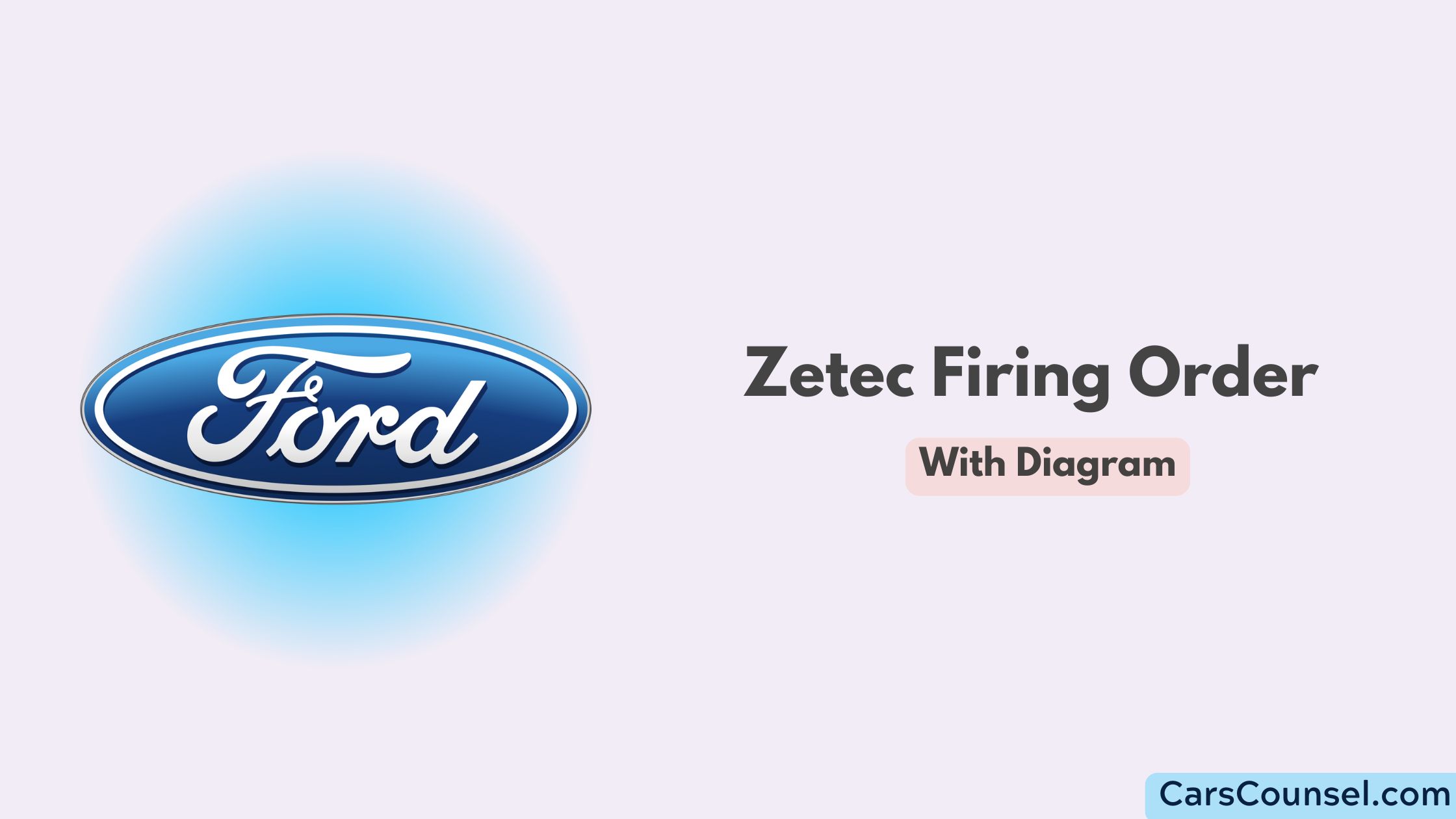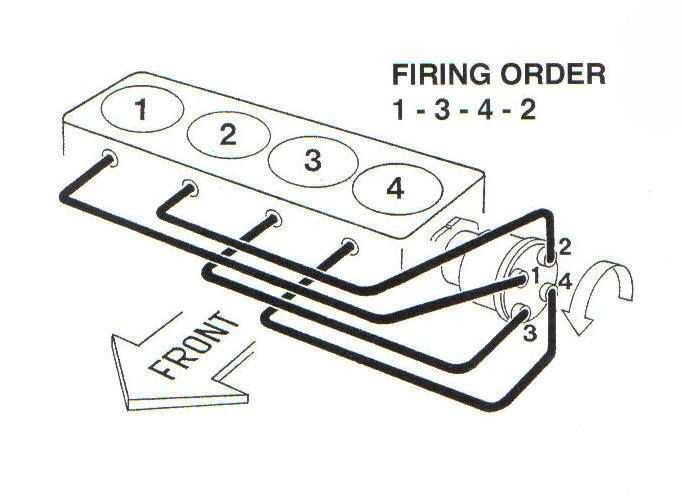The Ford Zetec engine is one of the most versatile and reliable inline-four engines produced by Ford. It is found in a variety of vehicles, including the Ford Focus, Fiesta, and Escort, and is celebrated for its efficiency, power, and durability. A critical aspect of its performance is the firing order, the sequence in which the engine’s cylinders fire to deliver smooth and balanced power.
In this guide, we’ll explore the firing order of the Zetec engine, explain why it matters, and offer practical tips for maintaining and troubleshooting it. Whether you’re a mechanic, car enthusiast, or Zetec owner, this article provides everything you need to know.

Quick Navigation
The Zetec Firing Order
The firing order for the Ford Zetec engine is: 1-3-4-2

How the Firing Order Works
- Cylinder 1 Fires First: Located at the front, closest to the timing belt, it starts the sequence.
- Cylinder 3 Fires Second: Ignition moves to the third cylinder, skipping the second for balance.
- Cylinder 4 Fires Third: The rearmost cylinder, closest to the flywheel, fires next.
- Cylinder 2 Fires Last: The second cylinder completes the sequence before restarting with Cylinder 1.
This firing order alternates between cylinders to ensure balanced operation and consistent power delivery.
Why Ford Uses the 1-3-4-2 Firing Order for Zetec
The 1-3-4-2 firing order is specifically chosen for the Zetec engine due to its advantages:
- Balance: Alternating combustion events prevent excessive vibrations, ensuring smooth operation.
- Crankshaft Design: Matches the crankshaft’s throw pattern, minimizing mechanical stress.
- Efficient Combustion: Proper spacing between ignition events allows for the complete burning of the air-fuel mixture.
- Durability: Reduces uneven wear on internal components, enhancing engine longevity.
What Is a Firing Order?
The firing order is the specific sequence in which the engine’s cylinders ignite the air-fuel mixture. This combustion generates the power needed to rotate the crankshaft and propel the vehicle.
For inline-four engines like the Zetec, the firing order is carefully designed to optimize efficiency, minimize vibrations, and ensure even power delivery.
Why the Firing Order Matters
- Smooth Operation: A balanced firing sequence reduces engine vibrations.
- Efficiency: Proper timing maximizes combustion efficiency, improving fuel economy.
- Durability: Correct firing distributes stress evenly across the crankshaft, extending its lifespan.
- Performance: Consistent torque output ensures smooth acceleration and reliable performance.
Overview of the Ford Zetec Engine
The Zetec engine family, introduced in the 1990s, has been a staple in Ford’s lineup. Known for its advanced engineering, it uses a 16-valve double overhead camshaft (DOHC) configuration, ensuring efficient airflow and combustion. Its compact design and lightweight construction make it an excellent choice for both performance and economy.
Key Features of the Zetec Engine
- Inline-Four Configuration: Four cylinders arranged in a straight line.
- DOHC Design: Dual overhead camshafts operate the intake and exhaust valves.
- Electronic Ignition: Uses a coil pack or distributorless ignition system (DIS) to manage spark delivery.
- Cylinder Numbering:
- Cylinders are numbered sequentially from front to rear:
- Cylinder 1 is closest to the timing belt.
- Cylinder 4 is closest to the flywheel.
- Cylinders are numbered sequentially from front to rear:
Identifying the Firing Order
Understanding the cylinder numbering and ignition system is crucial for setting or verifying the firing order.
Cylinder Numbering
The Zetec engine’s cylinders are numbered sequentially from front to rear:
- Cylinder 1: Closest to the timing belt.
- Cylinder 4: Closest to the flywheel.
Distributorless Ignition System (DIS)
Most Zetec engines use a DIS or coil pack, eliminating the traditional distributor. The coil pack sends sparks directly to the spark plugs based on the ECU’s instructions, ensuring the correct firing order.
Symptoms of an Incorrect Firing Order
An incorrect firing order can disrupt the engine’s performance and cause noticeable issues. Recognizing these symptoms can help diagnose and resolve problems quickly.
Common Symptoms
- Engine Misfires: Cylinders fail to ignite in the correct sequence, causing uneven power delivery.
- Rough Idling: The engine vibrates excessively or feels unstable at idle.
- Power Loss: Reduced performance and sluggish acceleration due to improper combustion.
- Backfiring: Combustion occurs in the intake or exhaust system due to incorrect timing.
- Increased Fuel Consumption: Inefficient combustion leads to higher fuel usage and emissions.
Diagnosing and Fixing Firing Order Problems
If you suspect firing order issues in your Zetec engine, follow these steps to diagnose and resolve them:
Diagnostic Steps
- Inspect Spark Plug Wires: Verify that each wire connects to the correct cylinder according to the 1-3-4-2 firing order.
- Check the Coil Pack: Ensure the coil pack is functioning properly and delivering spark to the correct cylinders.
- Use a Timing Light: Confirm that the ignition timing matches the manufacturer’s specifications.
- Perform a Compression Test: Ensure all cylinders have adequate compression to support proper firing.
Fixing Common Issues
- Reconnect Spark Plug Wires: Ensure each wire is routed to its respective cylinder in the correct sequence.
- Replace Faulty Components: Install new spark plugs, ignition wires, or coil packs if they show signs of wear or damage.
- Adjust Timing: Use diagnostic tools to recalibrate the ECU or adjust ignition timing as necessary.
Preventative Maintenance for Firing Order Reliability
Maintaining the correct firing order is essential for ensuring the longevity and performance of your Zetec engine. Follow these preventative measures:
Regular Inspections
- Check spark plugs, ignition wires, and the coil pack for wear or damage.
- Inspect timing components such as belts or chains for proper alignment.
Replace Components as Needed
- Replace spark plugs and ignition wires at intervals recommended by Ford.
- Use high-quality OEM parts to ensure reliability and compatibility.
Monitor Engine Performance
- Pay attention to changes in engine behavior, such as rough idling or reduced power.
- Use diagnostic tools regularly to identify and address potential issues.
Engines with Similar Firing Orders
- 2002 Ford Explorer Firing Order
- 2013 Ford Explorer Firing Order
- 2011 Ford Explorer Firing Order
- 2004 Ford Explorer Firing Order
- 2006 Ford Explorer Firing Order
FAQs About the Zetec Firing Order
Can I Change the Firing Order?
No, the firing order is determined by the engine’s design and crankshaft configuration. Altering it would require significant modifications.
What Happens If the Firing Order Is Incorrect?
An incorrect firing order can cause misfires, backfiring, power loss, and potential damage to the engine’s internal components.
How Can I Verify the Firing Order?
Refer to the service manual, inspect spark plug wire routing, and use diagnostic tools like a timing light to confirm the sequence.
Is the Firing Order the Same for All Inline-Four Engines?
While many inline-four engines share the 1-3-4-2 firing order, some manufacturers use variations based on engine design.
Conclusion
The 1-3-4-2 firing order is a fundamental aspect of the Ford Zetec engine’s design, ensuring smooth performance, balanced power delivery, and efficient combustion. Understanding and maintaining this sequence is critical for keeping your engine running reliably, whether you’re driving a Ford Focus, Fiesta, or Escort.
By following proper maintenance practices, using high-quality parts, and addressing issues promptly, you can ensure the longevity and performance of your Zetec engine. Whether you’re a DIY enthusiast or a seasoned mechanic, mastering the firing order is a key step in caring for this iconic inline-four engine.

